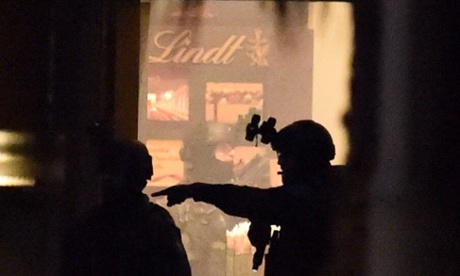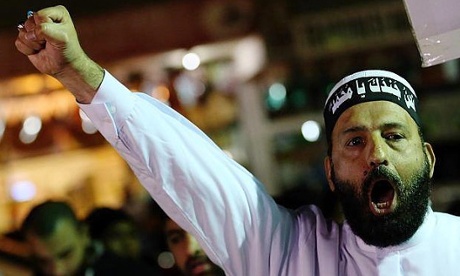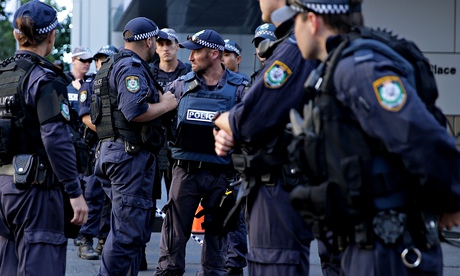 Victims named
Victims named
The Sydney siege should not be used to justify draconian new anti-terrorism laws
Australia was not changed by the attack in Martin Place. But it may be changed if these terrible events are used to defend new surveillance laws and curbs on press freedom

This will be used to justify so much: controversial security laws the Abbott government has already passed, the metadata retention law waiting in the wings and heaven knows what other laws may now be dreamed up in the aftermath of the shocking deaths in the Lindt cafe.
Dealing with Man Haron Monis never needed fancy new security laws. He has been on the radar of police – and probably Asio – since at least October 2009 when he turned up at a police station in Sydney’s western suburbs trying to report a bogus terrorist attack. He was charged, instead, with writing menacing letters to the families of soldiers killed in Afghanistan.
From that point until yesterday’s terrible events, police and Asio had all the authority they needed to keep track of a man who revealed himself over the years to be really nasty and really crazy.
Old laws allowed police to bug his phones, intercept his emails and place him under surveillance. They didn’t even need a warrant to access his metadata and track down everywhere Monis had been and everyone he was talking to year after year.
They didn’t need fresh laws threatening journalists with 10 years’ jail for revealing Asio’s newfangled “special” operations. Look at the superb cooperation the press displayed during the siege: forgoing scoop after scoop to follow the police strategy of denying Monis the oxygen of publicity.
In the months ahead, with due acknowledgement for the skill they showed in the siege, a failure of policing will have to be faced. Despite having all the powers they needed at their disposal, and despite Monis’s erratic behaviour over so many years, the Australian federal police, the NSW police and Asio weren’t able to prevent him putting into effect his crazy plan.
The cry will now go up for fresh powers. We’ll hear that old freedoms have to be curtailed and traditional restraints ditched in the interests of public security. There will be a clamour for grim legislation.
If new laws are needed, let’s have new laws. But these demands by politicians and police must be interrogated. And the questions that need to be asked should be absolutely practical: what new powers would have prevented that man from taking those hostages in Sydney on 15 December?
This is not a time for blanket new anti-terrorism laws. More facts may yet emerge, but Monis seems not to have been part of any terrorist operation. He wasn’t under orders. The horrors in the Lindt cafe seem to owe as much to Hollywood as terrorist manuals. All we know for certain is that Monis was a terrorist in his own crazy imagination.
Had he lived he would now be facing trial for terrible crimes. No gaps in the criminal law would have allowed him to escape punishment. No new statutes would be needed to send a man who did what he did to prison – almost certainly for the rest of his life. It’s all there.
Australia was not changed in the early hours of this morning. But it may be changed if these terrible events in Sydney are used to drive another agenda altogether: the criminalisation of the press and the needless extension of surveillance into the lives of all of us all in the name of fighting terrorism.
We’re entitled to ask why a firmer grip wasn’t applied to Sydney siege gunman Man Haron Monis
Facing over 40 charges and known to be threateningly unstable, Man Haron Monis had been granted bail three times in the past 12 months. Did the law fail?

The post-siege process underway includes a torrent of indignation, fused with the brilliance of hindsight.
For the families of those killed the grief is insurmountable. Other victims will be traumatised for a long time.
And there’s the questioning about the circumstances of the now dead hostage taker, Man Haron Monis. He was many things: a deranged bigot, with extreme religious beliefs, who posed a risk to the community. That is not the sum of him at all, but for these purposes it is enough.
As we know, at the time of his attack in Sydney’s Martin Place he was on bail in relation to two sets of alleged offences: as an accessory to the murder of his ex-wife and for over 40 sexual assault charges against seven women.
He was also known to the security authorities since 2007 when he engaged in a spree of hate letters to the families of Australian soldiers killed in Afghanistan, which he described as a “condolence card”.
In 2008 there were reports that Shia leader Kamal Mousselmani urged the AFP to investigate Monis’s bogus claims to be a spiritual leader with the name Sheikh Haron.
A Tehran-based journalist, Sadegh Ghorbani, claimed in Tweets on Tuesday that Iranian authorities repeatedly warned Australian authorities about Monis’s mental condition.
So he would have been on official radar screens for at least seven years and more likely 12 years after he arrived as a refugee from Iran in 1996.
It is at this point that the indignation mounts. Why was such a person outside the walls of a prison? How come he fell through the cracks in the criminal justice system? Why wasn’t the security apparatus more vigilant?
Hindsight makes us wonderfully wise. If the various judicial officers, through whose hands Monis passed, had an inkling that such a tragedy was to unfold they would no doubt have responded accordingly.
Magistrate Bill Pearce granted the accused bail on charges relating to accessory to murder. He found that the crown case was weak, that prosecution witnesses gave conflicting statements and that there was alibi evidence.
It is claimed Monis went to considerable efforts to plant a false trail in relation to the murder of his ex-wife. He is said to have concocted a heart attack on the day of the murder and set up a sham robbery of his flat which he reported on the same day.
Despite these claims, the magistrate set bail with conditions, including reporting daily to the police, being ordered to live at a place in Belmore and depositing $10,000 cash with the court. That was December 2013.
The following month, a 27-year-old woman complained to the police that Monis had sexually assaulted her. He was charged in April with three sexual assaults and refused bail. Then in May he was granted bail with roughly the same conditions imposed on him last December for the accessory case.
Following a police investigation he was charged in October with 40 sexual assault offences in relation to six women and bail was continued with an appearance due in Penrith Local Court on December 12, a date that was vacated and set at February 27, 2015.
We don’t know the exact details of the reasons behind the continuation of December’s bail in May and October. All we know is that magistrates are obliged to apply the law and usually take care to do so, otherwise they’ll be overturned higher up the judicial food chain.
The crown does not appear to have appealed against these bail determinations. Guardian Australia asked the office of the DPP to confirm this. It says it is still trying to check whether this is so.
This year’s amendments to the Bail Act, which apply stricter conditions to the grant of bail, haven’t come into effect yet, largely because the law and justice people are still trying to muddle out how the new model will work.
None of which will still a considerable amount of media and political law-and-order demagoguery.
What then of the gilded security apparatus that operates virtually as a state within a state – secretive, relatively unaccountable and bolstered by extravagant political patronage?
This man was known to be threateningly unstable, so we are entitled to ask why a firmer grip wasn’t applied to him, given the lavish powers at the disposal of counter-terrorism agencies.
The point about security people is that they are forever asking for bigger and better powers and this is granted by politicians anxious for insurance policies against nothing dreadful happening on their patch.
The latest round of beefed-up national security amendments was attended by proclamations from the attorney-general, Senator George Brandis, that “the most pressing gaps in our counter-terrorism legislative framework” have now been closed.
It is a claim that attends each new manifestation of counter-terrorism law.
At the disposal of the AFP in circumstances such as these are control orders and preventative detention orders.
Control orders can apply for up to 12 months, require a person to wear a tracking device and impose geographical restrictions and reporting conditions.
A preventative detention order (PDO) under Commonwealth law allows someone to be detained without charge for a maximum of 48 hours. However, they cannot be questioned.
Interestingly, the previous independent national security legislation monitor, Bret Walker, reported that PDOs are “worse than useless” because detainees cannot be questioned. “They are more trouble then they are worth,” he said.
The NSW Ombudsman recently found that the preventative detention laws in that state had never been used by the police between 2011 and 2013. However, within the month the Supreme Court had issued orders that three men be held without charge as part of September’s counter terrorism raids.
The amendments this September loosened the grounds on which applications can be made for these orders and extended the sunset provisions for a further 10 years.
It could be argued that the amendments and the accompanying chest beating from Brandis does nothing in terms of enhancing the counter-terror agencies’ capacity to hold or control someone like Monis without charge.
Nor would the proposed data retention scheme have helped. If the gunman in Martin Place was off the radar electronically, why would a programme under which the entire country can be put under surveillance make any difference?
Monis clearly learned his lesson after he was charged with sending offensive mail through the post. He said that from now on he should send his letters by “hand delivery”.
No doubt Asio, the AFP and others will be back for another helping of gap-closing pudding and in the process, once again, will be raised the question about where lies the balance between a free society and one in which the shadow of the state is too pervasive.
Sydney siege represents sum of all Australian fears over terror threat
Regardless of suspect’s motives, there is nagging concern over new breed of jihadists inspired by Isis extremism

For more than a year, Australian police and intelligence agencies have feared they could do little to stop the lone-wolf scenario. In that time, an increasing stream of citizens who were not on their radar have travelled to Syria and Iraq to fight. And though the motivation of the suspect in the Sydney cafe siege is unclear, individuals never before associated with radical causes have regularly been emerging as threats.
From the 9/11 attacks and the Bali bombings 13 months later until mass terror arrests in Sydney and Melbourne in 2005, the Australian Security Intelligence Organisation and the Australian federal police developed a strong understanding of the radical Islamist scene across the country. Even as the Iraq and Afghanistan campaigns wound down over the next five years, the threat matrix barely moved. While allies such as the US and UK were dealing with a constantly evolving target, the risk to Australia was more or less contained.
But Syria changed all that, and when Islamic State took over north-west Iraq it quickly became clear that a generational shift had occurred. The Pendennis generation – as security officials dub the 18 men jailed as part of the 2005 terror operation of the same name – are no longer the core of the extremist risk to Australia. And nor are their acolytes who remain on the streets, most of them closely watched.
The new threat comes from unknowns who have been galvanised by a fight on another faraway battlefield and to whom the virulent messages of Isis have proved appealing. At least 90 Australians are known to have travelled to Syria to join Isis or the al-Qaida-aligned group Jabhat al-Nusra. About 20 of them are known to have died.
Dozens more are thought to be acting in support of the new breed of jihadists or not yet sure whether to make the journey themselves. Some have had their passports confiscated – at one stage this year security officials were seizing up to four passports a week. Others have gone more quietly down a path of radicalisation that masks their potential danger.
There is another small and ill-defined number of citizens in the mix – those who have developed grievances over the past decade and are willing to hitch themselves to a terror group’s cause to settle personal scores. The Martin Place gunman, Man Haron Monis, appears to fit this category. The self-proclaimed cleric was on bail facing dozens of charges of indecent and sexual assault, all of which he denied, and has also been accused of being an accessory to the killing of his ex-wife – run-ins with the justice system that he resented.
To many Australians, regardless of the suspect’s motivations, the siege was the sum of all fears – an event that has moved from being considered fanciful in the post-9/11 days to almost inevitable just over a decade later. More Australians per capita than almost any other nationality have travelled to join Isis and Jabhat al-Nusra, a statistic that disturbs the government and preoccupies the intelligence community.
Australia’s Secret Intelligence Service has devoted a large swath of its resources to staying on top of the threat in the region, but there is a nagging fear that not enough can be done despite best intentions
http://www.theguardian.com/australia-news/2014/dec/15/sydney-siege-australian-terror-fears
